 Image search results - "Kanagawa" Image search results - "Kanagawa" |

Kanagawa Prefecture's largest Awa Odori is held annually during the last weekend in July in this city of Yamato. Preview event near Yamato Station.
|
|

Kanayama Jinja Shrine is a small shrine within the grounds of the Wakamiya Hachimangu Shrine near Kawasaki Daishi Station. On the first Sun. of April, it holds this now-famous Kanamara Festival nicknamed the Phallus or Fertility Festival. Festival starts at 11 am. But a large crowd was already there well before that time. Entrance to shrine on the day of the Kanamara Festival. (If you're below age 18, please leave now.)
|
|

From late April to early May, five long strings of giant carp streamers swim in the air high above the Sagami River in Sagamihara, Kanagawa. This event was started in 1988.
|
|
|

Shrine banners and cherries in full bloomThe red banner says "Kanayama Jinja" with an phallus (erect) logo on the top.
|
|

There are five rows of streamers. In Japan, the koi carp is regarded as a symbol of valiant manhood because it swims up the river against the rapids.
|
|

Pre-festival event held in the afternoon, Yamato Awa Odori
|
|

Pumping (or humping) the...
|
|

The cable length is 250 meters and 13mmm thick. There are about 1,200 carp streamers. They are reused every year and donated by local families. (I also noticed a few advertising carps.)
|
|
|

The festival is wildly popular with people from overseas.The shrine had various phallus props to pose with.
|
|
|

Yamato Station
|
|

Dickhead hat. Actually, I don't know what they call it, but that's what I call it.
|
|
|

Balloons, souvenirs and trinkets sold near the train station.
|
|

Carving daikon. Anybody can join in and carve. 大根削りLater to be auctioned off.
|
|

Sagami River Koi-nobori
|
|
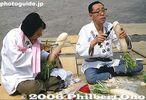
Carving daikon (old photo). These men were really good at carving the daikon.
|
|
|
|
|
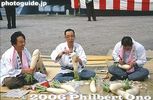
Carving daikon. Since some activities are conducted on the ground, the festival is also called Jibeta (Ground) Matsuri.Once upon a time, the festival was still mostly a local event with much fewer people.
|
|

Main drag and shopping arcade called Yamato Chuo-dori大和中央通り
|
|
|
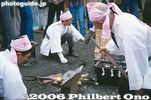
Forging a steel phallus (old photo)The demon living in the vagina of the women bit the man's phallus each time. So one guy made a steel phallus and the demom broke his teeth.
|
|

Spectators wait for the parade to begin.
|
|
|

Sugawara house from Tsuruoka city, Yamagata Prefecture. In heavy snow, the front window was used as the door.
|
|

June 9, 2007. Hula dancers rush to Pukari Sanbashi Pier where the Hokule'a canoe is to dock. ぷかりさん橋
|
|

The festival/parade starts before dark.
|
|

Standing room only at Wakamiya Shrine
|
|

The longest carp is 10 meters.
|
|

Ceiling
|
|

A crowd of a few hundred on hand to greet Hokule'a's arrival.
|
|
|

Packed path to Wakamiya Hachimangu Shrine
|
|
|
|

Kitamura house brought from Hadano, Kanagawa
|
|

People crowd the waterfront near Pukari Sanbashi Pier.
|
|
|

Prayers to the Kanamara Boat portable shrine かなまら舟神輿 神輿御霊入れ式Before the portable shrine is taken out to be paraded around town, the god of the shrine must be transferred to it. This is what the head priest is doing.
There are three portable shrines (called mikoshi). The Kanamara mikoshi (the original portable shrine), Kanamara-bune mikoshi (shaped like a boat), and Elizabeth mikoshi (pink giant). All three are carried during a procession around town. The Elizabeth mikoshi is carried by she-males. ("New half" in Japanese. Go ahead and laugh if you want.)
|
|

Along the river were food stalls.
|
|

Kitamura house
|
|

People crowd the waterfront near Pukari Sanbashi Pier.
|
|
|
|

Prayers to the Kanamara-bune mikoshi かなまら舟神輿Before the portable shrine is taken out to be paraded around town, the god of the shrine must be transferred to it. This is what the head priest is doing.
|
|

Festival site
|
|

Nihon Minkaen is an outdoor museum of traditional farm and merchant houses with thatched roofs. They have 25 homes from around Japan many were donated to the museum for preservation.
|
|

Hokule'a already in sight well before 11 am when it was scheduled to dock.
|
|
|

The shrine's head priest transfers the deity to the Kanamara Boat portable shrine (boat-shaped loaded with a phallus) かなまら舟神輿Before the portable shrine is taken out to be paraded around town, the god of the shrine must be transferred to it. This is what the head priest is doing.
|
|

Cable anchor
|
|
|
|

Hokule'a and escort ship Kama Hele. What makes this canoe so special and famous is that it was used to sail from Hawaii to Tahiti (and many other places) without any modern navigational instruments.
|
|
|

A representative of the shrine parishioners offer prayers.
|
|
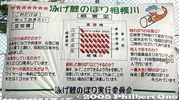
Statistics
|
|
|

They only referred to the sun, moon, the stars, and ocean waves to navigate through the vast Pacific Ocean or Polynesia. This is called celestial navigation. Extremely few people can do this, and the Hawaiians are learning this skill of long-ago.
|
|
|

Prayers to the Elizabeth portable shrine エリザベス神輿Before the portable shrine is taken out to be paraded around town, the god of the shrine must be transferred to it. This is what the head priest is doing.
|
|

Thatched roof
|
|

They wanted to prove that the original native Hawaiians were able to sail between Tahiti to Hawaii on purpose, and that they did not land on Hawaii by accident.
|
|
|

Waving the sacred sakaki branch to bless all of us
|
|

Water nozzles aimed at the house. No smoking.
|
|

Hokule'a and Yokohama Bay Bridge in the background.
|
|
|
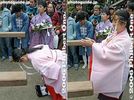
Prayers to the Elizabeth portable shrine エリザベス神輿Before the portable shrine is taken out to be paraded around town, the god of the shrine must be transferred to it. This is what the head priest is doing.
|
|
|

One sail unraveled.
|
|
|

Elizabeth portable shrine エリザベス神輿Before the portable shrine is taken out to be paraded around town, the god of the shrine must be transferred to it. This is what the head priest is doing.
There are three portable shrines (called mikoshi). The Kanamara mikoshi (the original portable shrine), Kanamara-bune mikoshi (shaped like a boat), and Elizabeth mikoshi (pink giant). All three are carried during a procession around town. The Elizabeth mikoshi is carried by she-males. ("New half" in Japanese. Go ahead and laugh if you want.)
|
|
|

Nearing Pukari Sanbashi Pier. The question was, which side of the pier would it dock? (Was going the other side so I rushed over to the other side.)
|
|
|

Pubic hair not included. Perhaps that's why it doesn't look so obscene.
|
|
|

Hokule'a nears the dock.
|
|

Mime act depicting a kite
|
|

Elizabeth portable shrine was donated by a drag queen club called Elizabeth Kaikan in Kameido, Tokyo.There are three portable shrines (called mikoshi). The Kanamara mikoshi (the original portable shrine), Kanamara-bune mikoshi (shaped like a boat), and Elizabeth mikoshi (pink giant). All three are carried during a procession around town. The Elizabeth mikoshi is carried by she-males. ("New half" in Japanese. Go ahead and laugh if you want.)
|
|

Yamada house
|
|

A rope is thrown to the dock from Hokule'a.
|
|

A fool's dance.
|
|

Kanamara Boat portable shrine (boat-shaped loaded with a phallus) was donated by a steel company. かなまら舟神There are three portable shrines (called mikoshi). The Kanamara mikoshi (the original portable shrine), Kanamara-bune mikoshi (shaped like a boat), and Elizabeth mikoshi (pink giant). All three are carried during a procession around town. The Elizabeth mikoshi is carried by she-males. ("New half" in Japanese. Go ahead and laugh if you want.)
|
|
|

Hokule'a arrives right on schedule at 11 am on June 9, 2007. Yokohama is its last stop.
|
|

End of the parade route.
|
|

Two of the portable shrines ready to go. In Japanese, the festival is nicknamed "Chinko Matsuri" (Phallus Festival) ちんこ祭り.There are three portable shrines (called mikoshi). The Kanamara mikoshi (the original portable shrine), Kanamara-bune mikoshi (shaped like a boat), and Elizabeth mikoshi (pink giant). All three are carried during a procession around town. The Elizabeth mikoshi is carried by she-males. ("New half" in Japanese. Go ahead and laugh if you want.)
|
|
|

Hula dancers
|
|
|

The main Kanamara mikoshi かなまら神輿There are three portable shrines (called mikoshi). The Kanamara mikoshi (the original portable shrine), Kanamara-bune mikoshi (shaped like a boat), and Elizabeth mikoshi (pink giant). All three are carried during a procession around town. The Elizabeth mikoshi is carried by she-males. ("New half" in Japanese. Go ahead and laugh if you want.)
|
|

Emukai house brought from Nanto, Toyama. In the gasshi-zukuri style with steep roof. Kawasaki Nihon Minkaen
|
|

Conch shell blowers signal the canoe's arrival.
|
|
|

Kanamara mikoshi かなまら神輿There are three portable shrines (called mikoshi). The Kanamara mikoshi (the original portable shrine), Kanamara-bune mikoshi (shaped like a boat), and Elizabeth mikoshi (pink giant). All three are carried during a procession around town. The Elizabeth mikoshi is carried by she-males. ("New half" in Japanese. Go ahead and laugh if you want.)
|
|

Nihon Minkaen, Kawasaki, Kanagawa
|
|

Pulling Hawaii's most famous canoe to dock.
|
|

Yamato Awa OdoriHeld in late July, Kanagawa Pref.
|
|

Ready for the procession
|
|

Inside Emukai house
|
|

Under overcast skies, Hokule'a docks.
|
|

Chidori-ren troupeちどり連
|
|

Taiko drummers in front of Wakamiya Hachimangu
|
|
|
|

ちどり連
|
|

Wakamiya Hachimangu Shrine
|
|
|

Escort ship (powered by a Yanmar engine) Kama Hele also docks soon afterward.
|
|

Yamato Awa Odori
|
|

Kanayama Shrine (right next to Wakamiya Hachimangu)Kanayama Shrine is dedicated to a pair of gods named Kanayama Hikonokami and Kanayama Himenokami 金山比古神(かなやまひこのかみ) 金山比売神(かなやまひめのかみ. According to legend, when the main Shinto god named Izanami gave birth to the God of Fire, her lower abdomen got burned. These two Kanayama gods helped to heal her birth wound. Thus, these two gods came to be known as the gods of childbirth and healing of the lower abdomen. They later came to be worshipped as fertility gods, protector of sexually-transmitted diseases (AIDS, etc.), and successful marriage. They are also the gods of the bellows, so blacksmiths (who use bellows to fan the fire) also worship this shrine.
Kanayama Shrine is a small shrine within the grounds of the larger Wakamiya Hachimangu Shrine. The Kanayama Shrine was completely rebuilt and reborn in 1999 into a completely unorthodox building which you see here. Modeled after a blacksmith's workshop, it is now a black, eight-sided building with steel paneling. Notice the penis monument on the lower right.
|
|
|

Koinobori carp streamers adorn Hokule'a. A great Japanese touch.
|
|
|

Penis prayersThis penis monument (built in 1995 by a steel company) is next to Kanayama Shrine. This person praying is a Caucasian man, not a woman. I was aghast when he stood up and showed his manly face. His long blond hair made me think he was a woman...
|
|
|
|
|

Licking it...Look at that tongue...
|
|
|

Escort ship Kama Hele flying the Japanese, Hawaiian, and Yanmar flags at Yokohama.
|
|
|

Riding it...Obviously I have better shots of her with her cute face showing and both arms in the air, but I'm not one to embarass people...
It has been scientifically proven that sex is good for your health and beauty.
|
|

Nihon Minkaen, Kawasaki, Kanagawa
|
|

Welcome banner from Yanmar
|
|
|

Ooohhh, ecstasy...Nah, just joking. She was actually just embarassed and spontaneously covered her face with a giggle. Obviously I have better shots of her with her cute face showing, but I'm not one to embarass people... Boy, I wish I took a video clip of this scene.
Actually, what happened is that a guy sat on this black penis before she did, and she saw that. So she imitated and sat on it too. Her female friend was taking her picture. Later they switched places and her friend, who was wearing a skirt and red net stockings, sat on it and posed for pictures.
Notice the zigzag white paper streamers. They indicate something which is sacred. So this penis is sacred, possessing a divine spirit. I can believe this because it draws so many people to it. It definitely has divine power. I mean it made this girl sit on it right?
|
|

Toilet
|
|

Crowd on the waterfront near the pier.
|
|

Woman drummer
|
|

Inside Kanayama Shrine 金山神社Kanayama Shrine is dedicated to a pair of gods named Kanayama Hikonokami and Kanayama Himenokami 金山比古神(かなやまひこのかみ) 金山比売神(かなやまひめのかみ. According to legend, when the main Shinto god named Izanami gave birth to the God of Fire, her lower abdomen got burned. These two Kanayama gods helped to heal her birth wound. Thus, these two gods came to be known as the gods of childbirth and healing of the lower abdomen. They later came to be worshipped as fertility gods, protector of sexually-transmitted diseases (AIDS, etc.), and successful marriage. They are also the gods of bellows (you can see it on the left of the fireplace above), so blacksmiths (who use bellows to fan the fire) also worship this shrine.
|
|

The museum park has 25 homes from around Japan many were donated to the museum for preservation. Near Mukogaoka-yuen Station on the Odakyu Line. Closed Mon. Admission 500 yen.
|
|

Hokule'a crew members
|
|
|

Inside Kanayama ShrineKanayama Shrine is dedicated to a pair of gods named Kanayama Hikonokami and Kanayama Himenokami 金山比古神(かなやまひこのかみ) 金山比売神(かなやまひめのかみ. According to legend, when the main Shinto god named Izanami gave birth to the God of Fire, her lower abdomen got burned. These two Kanayama gods helped to heal her birth wound. Thus, these two gods came to be known as the gods of childbirth and healing of the lower abdomen. They later came to be worshipped as fertility gods, protector of sexually-transmitted diseases (AIDS, etc.), and successful marriage. They are also the gods of bellows, so blacksmiths (who use bellows to fan the fire) also worship this shrine.
|
|

Water mill
|
|

The Royal Order of Kamehameha I take part in arrival ceremonies. 入港式
|
|
|

Inside Kanayama Shrine
|
|

Inside water mill
|
|

Hokule'a arrival ceremonies
|
|
|

Painting inside Kanayama Shrine
|
|

Hydrangea
|
|

Captain Bruce Blankenfeld places a lei on the bow.
|
|

Chidori-ren was my favorite of all.ちどり連
|
|

Kanayama Shrine altarFlanked by penis statues on the left and right.
|
|
|

Hula dancers
|
|
|

Kanayama Shrine altar
|
|
|

Hula dancers take part in arrival ceremonies.
|
|
|

Kanayama Shrine altar offeringsNotice the male and female mochi offering.
|
|
|
|

Their dance moves were outstanding.
|
|
|
|

Hokule'a crew dance on the canoe.
|
|

They were in great physical condition.
|
|

Shrine maiden
|
|
|
|

Royal Order of Kamehameha I
|
|

The men in Chidori-ren.
|
|

Giving offerings inside Kanayama Shrine
|
|

Royal Order of Kamehameha I wear red and gold capes.
|
|
|

Inside Kanayama Shrine
|
|

The old Kanayama ShrinePicture was taken in the 1980s.
|
|

Royal Order of Kamehameha I leave the pier.
|
|
|

The old Kanayama Shrine
|
|
|
|
|

The old Kanayama Shrine
|
|

Conch shell blower
|
|
|

Crew members hug each other.
|
|
|

Prayers for a child written on these votive tablets (ema)
|
|

Former Yokozuna Akebono (blue shirt) and his family were also on the pier. (Wife and daughter in orange.)
|
|

They are actually members of the Maritime Self-Defense Force based in Atsugi.
|
|

Shack for votive tablets
|
|

Nainoa Thompson and other crew members get off the boat. Nainoa was on board, but was not part of the crew who brought the canoe to Yokohama.
|
|

I kept chasing them along the parade route and got these great shots.
|
|
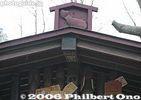
Roof ridge emblem
|
|
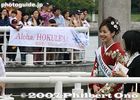
Miss Yokohama also took part in the arrival ceremonies.
|
|
|

Blacksmith's tool
|
|

Arrival ceremony ends and people start to leave the pier.
|
|
|

Another phallus near Kanayama ShrineIt was pretty lonely, with no one paying attention to it.
|
|

Future Hokule'a Captain, Ka'iu Murphy.
|
|
|
|

Happi coat with official logo
|
|

All the crew members met applause and handshakes.
|
|
|

Lollipop, lollipop, oh lolly-lollipop (pop!)...From an old song. These lollipops were selling like hotcakes.
|
|

All the crew members were very friendly to all. This is Captain/Navigator Chadd Paishon.
|
|
|

Free amazake (sweet sake). It's a white, creamy liquid served with small dried fish with wiggly tails. Sort of reminds you of something...Sperm!
|
|
|
|

Chidori-ren ちどり連
|
|

The crowd awaits the departure of the portable shrines to go on the procession around town.
|
|

Kimo
|
|

Yamato Awa Odori
|
|

People could borrow and wear kimono for free, courtesy of the shrine.The portable shrine procession is actually called a "costume parade." You can wear a mask or whatever and also wear a kimono (considered to be a costume) and join in the parade.
|
|

Captain Blankenfeld who piloted the canoe to Yokohama.
|
|
|

The Kanamara boat mikoshi is the first to leave. 神輿の巡幸
|
|

Finally, Nainoa Thompson makes his way from the pier and into the crowd.
|
|
|

The Kanamara boat mikoshi is the first to leave.
|
|

Nainoa Thompson
|
|

ちどり連
|
|

Kanamara boat mikoshi
|
|

Nainoa shook every single hand.
|
|

Chidori-ren at Yamato Awa Odori
|
|

Phallus in the Kanamara boat mikoshi
|
|

He shook hands with EVERYBODY and ANYBODY.
|
|
|

The outlandish Elizabeth mikoshi carried by she-males.
|
|
|
|
|

The crowd was thrilled to be so close to this man full of aloha.
|
|
|

The Elizabeth mikoshi pumping up and down as it makes it way to town
|
|

People line up to shake Nainoa's hand or get his autograph or take his picture.
|
|
|
|

The main Kanamara mikoshi leaves last.
|
|
|
|

Kanamara mikoshi
|
|

Nainoa has a habit of crouching on his knees so he can use his knee as a backing to sign autographs.
|
|
|

Kanamara mikoshi
|
|

"Here you go!"
|
|
|

Kanamara mikoshi salutes the Wakamiya Hachimangu Shrine
|
|

Plus a handshake for this little guy...
|
|

Kanamara mikoshi salutes the Wakamiya Hachimangu Shrine
|
|

He never refused to sign an autograph.
|
|

And it leaves the shrine.
|
|
|

Heading out to the torii gate 神輿の巡幸
|
|

Heading out of the shrine (old photo)This picture was taken in the 1980s.
|
|

He never refused to shake a hand.
|
|
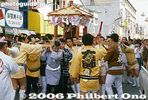
Old photoThis picture was taken in the 1980s.
|
|
| 3189 files on 13 page(s) |
1 |
 |
 |
 |
 |
|